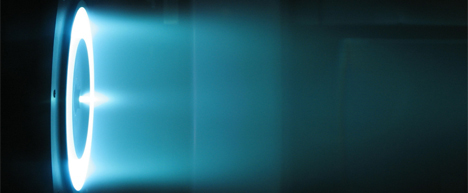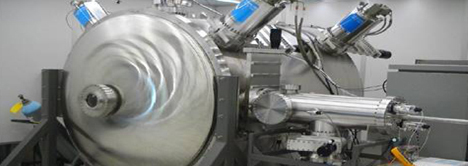Electric Propulsion Laboratory

The Electric Propulsion (EP) laboratory at JPL maintains several vacuum facilities for evaluating the operation, performance, lifetime, and integration of electric thrusters and related technologies on deep-space missions. Chambers range in size from small bell jars to the large 3 m diameter by 10 m long Endurance Test Facility used for high-power EP thruster testing. Most chambers are cryopumped with sufficient pumping speed to handle flow rates typical of electric thrusters. Thermal vacuum testing is accomplished with a large thermal shroud for testing over temperatures of -120 to 370 degrees C. Vibration testing is also available using other facilities at JPL. Diagnostics include several thrust stands and multiple optical- or probe-based systems for measuring plasma properties. Test facilities are equipped with on-site machine tools and fabrication equipment for support of test activities. There is significant electrical power and liquid nitrogen infrastructure for facility operation. A wide range of power supplies is available with up to kilovolt and kiloamp capabilities, electrical diagnostic equipment, and data acquisition equipment are available. Most facilities are setup to safely operate unattended for long duration tests. A 420 sq. ft., class 10,000 clean room is available for test and flight hardware. Our facilities and personnel are available to support development activities in government, academia, and industry. Our three primary facilities are described below. Contact the EP group supervisor for further details.
Endurance Test Facility
The Endurance Test Facility is a 3 m diameter by 10 m long vacuum chamber used previously for the 30 kh life test of the 2.3 kW NSTAR ion thruster and has also been used to test Hall thrusters and Ion thrusters at power levels up to 20 kW. The facility is cryogenically pumped and is lined with graphite panels to minimize backsputtered material to thruster surfaces. Base pressures of as little as 10-8 torr are routinely achieved and the measured pumping speed of the facility on xenon is 400,000 l/s. A high-resolution thrust stand is available for measurements over 0.001 - 1 N. Additionally, arrays of plasma probes and optical diagnostics (infrared camera, high-speed visible camera, and laser induced fluorescence) are available for interrogating the interior and plume regions of thrusters.
Microthrust Propulsion Laboratory

The Microthrust Propulsion Laboratory is a Class-10-capable, 1000 sq. ft. cleanroom equipped with services and workstations for multiple projects. The facility features a 2 m diameter, 2 m long ultra-high vacuum (UHV) test chamber capable of reaching the 10-9 Torr range, a requirement to adequately assess microthruster performance, neutralizer integration, lifetime, and potential spacecraft contamination issues. The chamber also features a Nano-Newton Thrust Stand (nNTS) capable of < 0.5 micronewton resolution thrust measurements.
Condensable Metal Propellant Vacuum Facility
The Condensable Metal Propellant Vacuum Facility is a unique national asset for developing high-power, liquid-metal fueled propulsion systems. It is the only large-volume vacuum facility in the nation capable of testing high-power (0.1-1.0 MW), liquid-metal fueled thrusters and is equipped with water-cooled shrouds providing up to 2.5 MW cooling/pumping capacity. Steady-state power up to 1.0 MW is presently available. The chamber measures 3 m diameter by 8 m long. Light gases are pumped with diffusion pumps with a pumping speed of 74,000 l/s on air.
- Richard Hofer - Electric Propulsion Group Supervisor